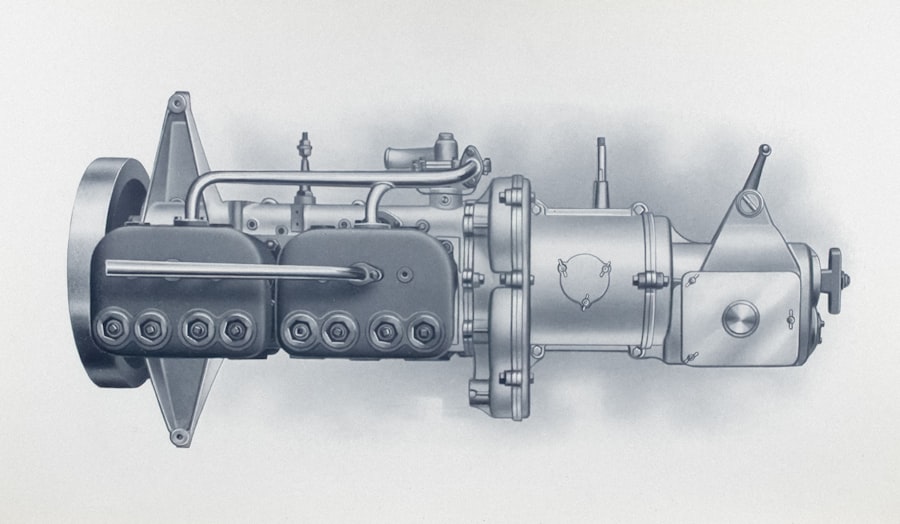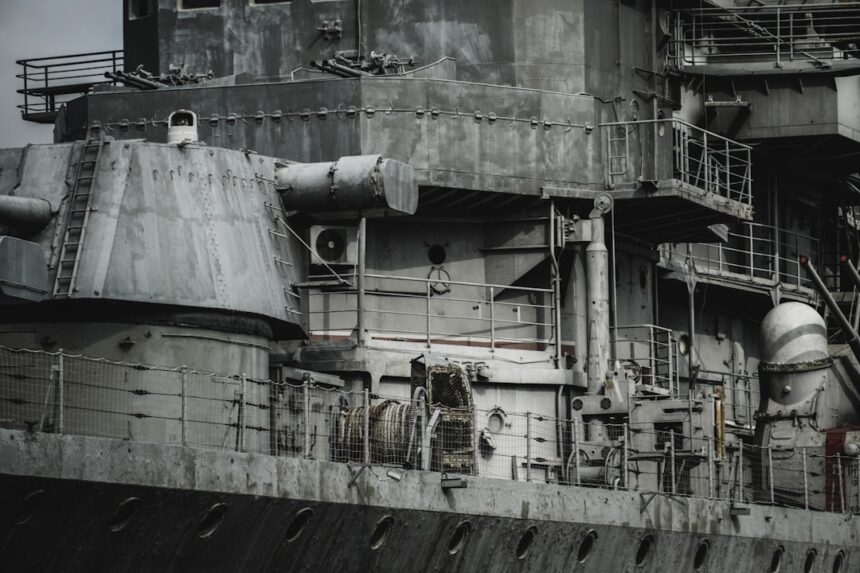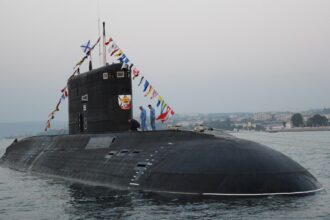The MK 48 torpedo, a heavyweight torpedo designed for use by the United States Navy, has its roots in the technological advancements of the mid-20th century. Developed during the Cold War, the MK 48 was conceived as a response to the growing threat posed by advanced Soviet submarines. The initial design process began in the late 1950s, with the aim of creating a weapon that could effectively engage enemy submarines and surface vessels.
The MK 48 was intended to replace earlier torpedoes, such as the MK 14 and MK 37, which were deemed inadequate against the more sophisticated threats emerging at that time. The development of the MK 48 involved extensive research and testing, leading to a series of prototypes that underwent rigorous evaluation. Engineers focused on enhancing its range, speed, and guidance systems to ensure it could effectively track and destroy targets in various maritime environments.
By the time it entered service in the late 1970s, the MK 48 had evolved into a formidable weapon, equipped with advanced sonar systems and a powerful warhead capable of delivering devastating damage to enemy vessels. Its introduction marked a significant milestone in naval warfare technology, setting new standards for submarine-launched munitions.
Key Takeaways
- The MK 48 Torpedo was developed as a heavyweight anti-submarine torpedo for the United States Navy in the 1970s.
- The MK 48 Torpedo plays a crucial role in submarine warfare, providing a long-range, highly accurate weapon for engaging enemy submarines.
- The technology of the MK 48 Torpedo has evolved over the years, incorporating advanced guidance systems and improved propulsion for enhanced performance.
- The MK 48 Torpedo has had a significant impact on naval operations, increasing the effectiveness of submarine warfare and influencing naval strategy.
- During the Cold War, the MK 48 Torpedo played a vital role in deterring potential adversaries and maintaining national defense.
The Role of the MK 48 Torpedo in Submarine Warfare
The MK 48 torpedo plays a pivotal role in submarine warfare, serving as a primary weapon for attack submarines in the U.S. Navy’s arsenal. Its design allows for deployment from various platforms, including nuclear-powered submarines, which enhances its versatility in combat scenarios.
The torpedo’s ability to engage both surface ships and submarines makes it an essential tool for maintaining naval superiority. Submarines equipped with the MK 48 can operate stealthily, launching surprise attacks on enemy vessels while remaining undetected. In addition to its offensive capabilities, the MK 48 also serves a strategic purpose in deterrence.
The mere presence of submarines armed with these torpedoes can dissuade potential adversaries from engaging in hostile actions. The psychological impact of knowing that an adversary possesses such advanced weaponry can influence decision-making at the highest levels of military strategy. As a result, the MK 48 not only enhances the tactical capabilities of submarines but also contributes to broader strategic objectives in maintaining maritime security.
The Evolution of the MK 48 Torpedo’s Technology

Over the decades, the technology behind the MK 48 torpedo has undergone significant evolution to keep pace with advancements in naval warfare and countermeasures. Initially designed with analog systems, subsequent upgrades have incorporated digital technology, enhancing its guidance and targeting capabilities. The introduction of advanced sonar systems has allowed the MK 48 to detect and track targets more effectively, even in challenging underwater environments where noise and other factors can complicate targeting.
Moreover, improvements in propulsion technology have increased the torpedo’s speed and range, enabling it to engage targets at greater distances. The integration of sophisticated algorithms for target recognition and engagement has further refined its operational effectiveness. These technological advancements ensure that the MK 48 remains relevant in modern warfare, capable of adapting to new threats and challenges posed by evolving naval capabilities around the world.
The MK 48 Torpedo’s Impact on Naval Operations
| Impact on Naval Operations | Metrics |
|---|---|
| Increased Lethality | Ability to engage and destroy a wide range of targets |
| Improved Range and Accuracy | Capable of engaging targets at long ranges with high accuracy |
| Enhanced Anti-Submarine Warfare (ASW) Capability | Effective in detecting and neutralizing enemy submarines |
| Impact on Enemy Naval Forces | Ability to disrupt and destroy enemy naval assets |
The impact of the MK 48 torpedo on naval operations cannot be overstated. Its introduction has transformed how naval forces conduct anti-submarine warfare (ASW) and surface warfare operations. With its ability to engage multiple types of targets, the MK 48 has become a cornerstone of U.S.
Navy tactics, allowing for flexible responses to various maritime threats. Submarines armed with this torpedo can operate independently or as part of larger task forces, providing critical support in joint operations. Furthermore, the MK 48’s effectiveness has influenced naval doctrine and strategy.
Commanders now incorporate its capabilities into their operational planning, ensuring that submarines equipped with this weapon are positioned strategically to maximize their impact during conflicts. The ability to launch precision strikes from stealthy platforms has reshaped naval engagements, allowing for more effective use of resources and enhancing overall mission success rates.
The MK 48 Torpedo’s Role in Cold War Conflicts
During the Cold War, the MK 48 torpedo played a crucial role in shaping naval engagements between NATO forces and the Soviet Union. As tensions escalated between these superpowers, the need for effective anti-submarine capabilities became paramount. The MK 48 was deployed extensively in various theaters, including the Atlantic and Pacific Oceans, where it was used to counter Soviet submarine threats.
Its advanced technology provided U.S. forces with a significant advantage in detecting and neutralizing enemy submarines. The Cold War era also saw an increase in naval exercises and operations designed to demonstrate the capabilities of the MK 48.
These exercises served not only as training opportunities but also as strategic signals to adversaries regarding U.S. military readiness and technological superiority. The successful deployment of the MK 48 during this period solidified its reputation as a key asset in maintaining maritime security and deterring potential aggression from rival nations.
The MK 48 Torpedo’s Contribution to National Defense

The contribution of the MK 48 torpedo to national defense extends beyond its immediate tactical applications; it embodies a broader commitment to ensuring maritime security and protecting national interests. As a critical component of the U.S. Navy’s arsenal, the MK 48 enhances deterrence capabilities against potential adversaries who may seek to challenge U.S.
naval dominance. Its presence in strategic locations around the globe serves as a reminder of U.S. military strength and resolve.
Moreover, the ongoing investment in upgrading and maintaining the MK 48 reflects a commitment to adapting to emerging threats in an ever-evolving global security landscape. As new technologies and geopolitical dynamics emerge, ensuring that this torpedo remains effective is vital for safeguarding national interests. The MK 48’s role in national defense underscores its importance not only as a weapon but also as a symbol of military preparedness and strategic foresight.
The MK 48 Torpedo’s Influence on Naval Strategy
The influence of the MK 48 torpedo on naval strategy is profound, shaping how naval forces approach both offensive and defensive operations. Its capabilities have led to a reevaluation of traditional naval tactics, emphasizing stealth and precision over sheer firepower. Commanders now prioritize submarine warfare as a critical element of naval strategy, recognizing that submarines equipped with advanced torpedoes can operate effectively in contested environments.
Additionally, the integration of the MK 48 into joint operations with other branches of the military has fostered greater collaboration among U.S. forces. The ability to coordinate submarine-launched strikes with air and surface operations enhances overall mission effectiveness and allows for more comprehensive responses to threats.
This shift towards integrated warfare reflects a broader understanding of modern conflict dynamics, where multiple domains must be considered for successful outcomes.
The MK 48 Torpedo’s Adaptation to Modern Warfare
As warfare continues to evolve with advancements in technology and changes in geopolitical landscapes, so too has the MK 48 torpedo adapted to meet new challenges. Modern threats require more sophisticated responses, prompting ongoing upgrades to enhance its capabilities further. Recent iterations have incorporated features such as improved guidance systems that utilize artificial intelligence for better target discrimination and engagement.
Moreover, adaptations have been made to ensure compatibility with emerging platforms and technologies within naval operations. As unmanned systems become more prevalent in military engagements, integrating these technologies with traditional weapons like the MK 48 will be essential for maintaining operational effectiveness.
S.
The MK 48 Torpedo’s Role in International Naval Exercises
The role of the MK 48 torpedo extends beyond direct combat applications; it is also integral to international naval exercises that promote interoperability among allied forces. These exercises often simulate real-world scenarios where submarines equipped with MK 48s engage in joint operations with surface ships and aircraft from various nations. Such collaborative training enhances mutual understanding and strengthens alliances among participating countries.
Through these exercises, navies can assess their readiness to respond to potential threats while sharing best practices for employing advanced weaponry like the MK 48. The lessons learned during these drills contribute not only to individual national capabilities but also foster collective security arrangements among allies. As global maritime challenges continue to evolve, these international exercises underscore the importance of cooperation in addressing shared security concerns.
The Future of the MK 48 Torpedo
Looking ahead, the future of the MK 48 torpedo appears promising as ongoing advancements in technology continue to shape its development. As naval warfare becomes increasingly complex, there is a clear need for weapons systems that can adapt rapidly to changing conditions on the battlefield. Future iterations of the MK 48 are likely to incorporate cutting-edge technologies such as enhanced sensor arrays and improved data processing capabilities.
Moreover, as nations invest in countermeasures against traditional torpedoes, ongoing research will focus on developing counter-countermeasures that ensure the effectiveness of the MK 48 remains intact. This commitment to innovation will be crucial for maintaining its status as a premier weapon system within modern naval arsenals.
The Legacy of the MK 48 Torpedo
The legacy of the MK 48 torpedo is one marked by innovation, adaptability, and strategic significance within naval warfare history. Since its inception, it has evolved into one of the most formidable weapons systems available to modern navies worldwide. Its impact on submarine warfare tactics and broader naval strategy has been profound, influencing how nations approach maritime security challenges.
As military technologies continue to advance and geopolitical dynamics shift, the legacy of the MK 48 will endure through its ongoing contributions to national defense and international security efforts. It stands as a testament to human ingenuity in addressing complex challenges at sea while serving as a reminder of the importance of maintaining robust maritime capabilities in an increasingly interconnected world.
The secret history of the MK 48 torpedo is a fascinating tale of innovation and strategic development during the Cold War era. For those interested in exploring more about military advancements and their historical contexts, a related article can be found on the War Room website. This article delves into various aspects of military technology and strategy, providing a broader understanding of the innovations that have shaped modern warfare. To read more about these intriguing topics, visit the War Room’s homepage.
WATCH THIS! America’s Nuclear Navy Was Born From Espionage
FAQs
What is the MK 48 torpedo?
The MK 48 torpedo is a heavyweight torpedo designed for use by the United States Navy and other allied navies. It is designed to be launched from submarines and is used for anti-submarine and anti-surface warfare.
When was the MK 48 torpedo first developed?
The MK 48 torpedo was first developed in the 1970s and has undergone several upgrades and improvements since its initial development.
What are the key features of the MK 48 torpedo?
The MK 48 torpedo is capable of both acoustic homing and wire-guided modes, and it is equipped with advanced sonar and guidance systems. It has a range of over 5 miles and can travel at speeds of up to 28 knots.
What is the secret history of the MK 48 torpedo?
The secret history of the MK 48 torpedo refers to the classified details of its development, capabilities, and operational use. This may include information about specific missions, technological advancements, and strategic uses of the torpedo.
How has the MK 48 torpedo been used in military operations?
The MK 48 torpedo has been used in various military operations by the United States Navy and other allied navies. Its precise operational history and specific uses may be classified.




